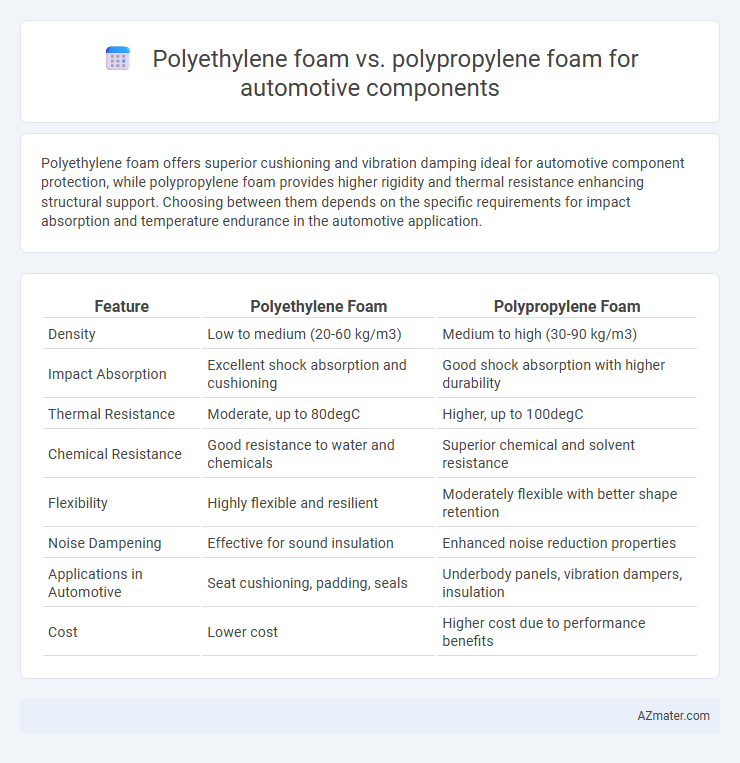Polyethylene foam offers superior cushioning and vibration damping ideal for automotive component protection, while polypropylene foam provides higher rigidity and thermal resistance enhancing structural support. Choosing between them depends on the specific requirements for impact absorption and temperature endurance in the automotive application.
Table of Comparison
| Feature | Polyethylene Foam | Polypropylene Foam |
|---|---|---|
| Density | Low to medium (20-60 kg/m3) | Medium to high (30-90 kg/m3) |
| Impact Absorption | Excellent shock absorption and cushioning | Good shock absorption with higher durability |
| Thermal Resistance | Moderate, up to 80degC | Higher, up to 100degC |
| Chemical Resistance | Good resistance to water and chemicals | Superior chemical and solvent resistance |
| Flexibility | Highly flexible and resilient | Moderately flexible with better shape retention |
| Noise Dampening | Effective for sound insulation | Enhanced noise reduction properties |
| Applications in Automotive | Seat cushioning, padding, seals | Underbody panels, vibration dampers, insulation |
| Cost | Lower cost | Higher cost due to performance benefits |
Introduction to Polyethylene and Polypropylene Foams
Polyethylene foam is a lightweight, closed-cell material known for its excellent cushioning, impact absorption, and moisture resistance, making it ideal for automotive components such as seals, gaskets, and insulation. Polypropylene foam offers higher temperature tolerance, chemical resistance, and superior rigidity, contributing to its use in structural automotive parts and vibration damping applications. Both foams provide distinct benefits in noise reduction, durability, and weight savings, critical factors in automotive design and manufacturing.
Key Properties of Polyethylene Foam
Polyethylene foam exhibits excellent impact absorption, high flexibility, and superior resistance to moisture and chemicals, making it ideal for automotive components requiring durability and cushioning. Its closed-cell structure ensures lightweight characteristics while providing exceptional thermal insulation and sound dampening properties. Compared to polypropylene foam, polyethylene foam offers enhanced compressive strength and resilience, crucial for withstanding vibrations and shocks in automotive applications.
Key Properties of Polypropylene Foam
Polypropylene foam offers superior chemical resistance, high tensile strength, and excellent thermal stability compared to polyethylene foam, making it ideal for automotive components exposed to harsh environments and temperature fluctuations. Its lightweight structure provides effective vibration damping and noise reduction, enhancing vehicle comfort and durability. Polypropylene foam's ability to withstand higher impact forces and resist fuel and oil degradation ensures longer-lasting performance in automotive applications.
Application of Foams in Automotive Components
Polyethylene foam offers excellent impact absorption and thermal insulation, making it ideal for automotive seating, door panels, and soundproofing applications. Polypropylene foam provides superior chemical resistance and dimensional stability, commonly used in under-the-hood components and exterior trim parts requiring lightweight durability. Both foams enhance vehicle safety and comfort while contributing to weight reduction and fuel efficiency.
Comparative Analysis: Durability and Resilience
Polyethylene foam offers superior impact absorption and excellent resistance to moisture, making it highly durable for automotive components exposed to vibrations and environmental stress. Polypropylene foam, while lighter and stiffer, exhibits greater chemical resistance and higher temperature tolerance, enhancing its resilience in under-hood applications. Comparing durability, polyethylene foam excels in cushioning and flexibility, whereas polypropylene foam provides enhanced structural integrity and longevity under thermal cycling conditions.
Thermal and Chemical Resistance Comparison
Polypropylene foam demonstrates superior thermal resistance compared to polyethylene foam, withstanding continuous temperatures up to 100degC versus polyethylene's limit around 80degC, making it more suitable for automotive components exposed to higher heat. Chemically, polypropylene foam offers greater resistance to oils, solvents, and fuels common in automotive environments, whereas polyethylene foam can degrade when exposed to certain hydrocarbons and chemicals. These properties make polypropylene foam a preferred choice for automotive parts requiring both enhanced thermal stability and robust chemical resistance.
Weight and Density Considerations
Polyethylene foam offers lower density, typically around 20-30 kg/m3, making it an excellent choice for automotive components requiring lightweight materials to enhance fuel efficiency. Polypropylene foam, with a slightly higher density range of 40-60 kg/m3, provides greater structural integrity and impact resistance, beneficial for applications demanding durability. Weight considerations favor polyethylene foam for minimizing overall vehicle mass, while polypropylene foam balances density with improved mechanical performance.
Cost-Effectiveness in Automotive Manufacturing
Polyethylene foam offers superior cost-effectiveness in automotive manufacturing due to its lower raw material and production costs compared to polypropylene foam. It provides excellent cushioning and vibration dampening at a reduced price, making it ideal for non-structural automotive components. While polypropylene foam has better thermal resistance and strength, polyethylene foam is preferred for budget-sensitive applications where lightweight and impact absorption are critical.
Environmental Impact and Recyclability
Polyethylene foam offers superior recyclability due to its widespread acceptance in recycling streams and relatively low environmental impact compared to polypropylene foam, which has more complex recycling processes and higher carbon emissions during production. Polypropylene foam provides better durability and chemical resistance, often resulting in longer lifespan automotive components that may reduce waste generation over time but present challenges in eco-friendly disposal. Choosing between these foams for automotive components requires balancing polyethylene's environmental benefits and recyclability against polypropylene's mechanical advantages and potential long-term sustainability implications.
Choosing the Right Foam for Automotive Applications
Polyethylene foam offers excellent impact absorption and moisture resistance, making it ideal for automotive components exposed to vibration and harsh environmental conditions. Polypropylene foam provides superior chemical resistance and higher temperature tolerance, suitable for under-the-hood applications and areas requiring durability against fuel and oil exposure. Selecting the right foam depends on the specific automotive application requirements such as thermal stability, mechanical strength, and environmental exposure.

Infographic: Polyethylene foam vs Polypropylene foam for Automotive component
 azmater.com
azmater.com